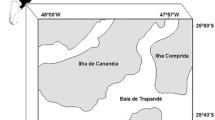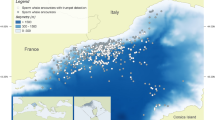Abstract
The underwater vocalizations of the beluga whale summering in Onega Bay (64°24′N, 35°49′E) were recorded in June–July of 2008. The vocalizations were classified into five major whistle types, four types of pulsed tones, click series, and noise vocalizations. To determine the relationship between the behavioral activity and the underwater vocalizations, a total of fifty-one 2 minute-long samples of the audio records were analyzed in the next six behavioral contexts: directional movements, quiet swimming, resting, social interactions, individual hunting behavior, and the exploration of hydrophones by beluga whales. The overall vocalization rate and the percentage of the main types of signals depend on the behavior of the belugas. We suggest that one of the whistle types (the “stereotype whistle”) is used by belugas for long-distance communications, while other whistle types (with the exception of “squeaks”) and three types of pulsed tones (with the exception of “vowels”) are used for short distance communication. The percentage of “squeaks” and “vowels” was equally high in all the behavioral situations. Thus, we assume that “squeaks” are contact signals. “Vowels” have a specific physical structure and probably play a role in identification signals. A high rate of the click series was observed in the process of social interactions.
Similar content being viewed by others
References
A. V. Agafonov, “Characteristics of the Acoustic Activity of Beluga Whale by the Results of Audial Analysis,” in Proc. 8th All-Union Conf. for the Study, Protection, and Sustainable Use of Marine Mammals (Astrakhan’: Minist. Rybn. Khoz., 1982), pp. 3–4 [in Russian].
A. V. Agafonov, Ya. I. Alekseeva, and V. M. Bel’kovich, “The Investigation of Behavior and Under-water Acoustical Activity of Beluga Whales (Delphinapterus leucas) of the Myagostov Breeding Aggregation,” in Marine Mammals of Holarctic: Collection of Scientific Papers (KMK, Odessa, 2008), pp. 20–24.
R. A. Belikov and V. M. Bel’kovich, “The Acoustic Repertoire of the White Sea Beluga (Delphinapterus leucas) in the Solovki Herd Reproductive Aggregation,” in Fundamental Studies of the Oceans and Seas in two books, Ed. by N. P. Laverov (Nauka, Moscow, 2006), pp. 299–337 [in Russian].
R. A. Belikov and V. M. Bel’kovich, “High-Pitched Tonal Signals of Beluga Whales (Delphinapterus leucas) in a Summer Assemblage off Solovetskii Island in the White Sea,” Acoustical Physics 52(2), pp. 125–131 (2006).
V. M. Bel’kovich, “Beluga Whales of the European North: Recent Studies,” Rybn. Khoz. No. 2, pp. 32–34 (2004) [in Russian].
V. M. Bel’kovich and S. A. Kreichi, “Specific Features of Vowel-Like Signals of White Whales,” Acoustical Physics, 50(3), pp. 288–294 (2004).
V. M. Bel’kovich, E. M. Panova, R. A. Belikov, and A. V. Agafonov, “Stability and Variability of Acoustic Signals of White Sea Beluga Whale,” in Physical, Geological, and Biological Studies of Oceans and Seas, Ed. by S.M. Shapovalov (Nauchnyi mir, Moscow, 2010) [in Russian].
V. M. Bel’kovitch and M. N. Sh’ekotov, The Belukha whale: Natural behaviour and bioacoustics. Woods Hole, MA: Woods Hole Oceanographic Institution. 1993.
I. A. Volodin, E. V. Volodina, and O. A. Filatova, “Structural Features, Occurrence and Functional Significance of Nonlinear Phenomena in the Sounds of Terrestrial Mammals,” Zh. Obshch. Biol. 66(4), pp. 346–362 (2005).
V. D. Il’ichev, N. N. Kartashev, and I. A. Shilov, General Ornithology (Vyssh. Shkola, Moscow, 1982) [in Russian].
S. A. Krechy and V. M. Bel’kovich, “The Individual Differences in Spectral-temporal Structures of the Beluga’s Vowel Sounds,” in Marine Mammals of the Holarctic. Abstr. Conf. (KMK, Moscow, 2004), pp. 291–294.
L. A. Osipova, R. A. Belikov, A. V. Agafonov, and V. M. Bel’kovich, “The analysis of individual characteristics of possible identification sounds of belugas (Delphinapterus leucas),” Marine Mammals of the Holarctic: Collection of Scientific Papers (KMK, Odessa, 2008), pp. 401–405.
O. Yu. Rebrova, Statistical Analysis of Medical Data. Application of the Statistica Software Package (Mediasfera, Moscow, 2002) [in Russian].
M. N. Shchekotov, “Acoustic Signaling and Behavior of the White Sea Beluga Whale under Stress,” in Behavior and Bioacoustics of Cetacean (IO AN SSSR, Moscow, 1987), pp. 110–147 [in Russian].
F. T. Awbrey, J. A. Thomas, and R. A. Kastelein, “Low-Frequency Underwater Hearing Sensitivity in Belugas, Delphinapterus leucas,” J. Acoust. Soc. Am. 84(6), pp. 2273–2275 (1988).
R. A. Belikov and V. M. Bel’kovich, “Underwater Vocalization of the Beluga Whales (Delphinapterus leucas) in a Reproductive Gathering in Various Behavioral Situations,” Oceanology 43(1), pp. 112–120 (2003).
M. C. Caldwell and D. K. Caldwell, “Individualized Whistle Contours in Bottlenose Dolphins (Tursiops truncates),” Science 207, pp. 434–435 (1965).
A. Faucher, The Vocal Repertoire of the St. Lawrence Estuary Population of Beluga Whale (Delphinapterus leucas) and Its Behavioral, Social and Environmental Contexts, MSc Thesis (Dalhousie University, 1988).
M. R. Fish and W. H. Mowbray, “Production of Underwater Sounds by the White Whale or Beluga Delphinapterus leucas (Pallas),” J. Mar. Res. 20(2), pp. 149–162 (1962).
J. K. B. Ford, “Acoustic Behavior of Resident Killer Whales (Orcinus orca) Off Vancouver Island, British Columbia,” Can. J. Zool. 67, pp. 727–745 (1989).
V. M. Janik, “Source Levels and the Estimated Active Space of Bottlenose Dolphin (Tursiops truncates) Whistles in the Moray Firth, Scotland,” J. Comp. Physiol. 186, pp. 673–680 (2000).
J. D. Karlsen, A. Bisther, C. Lyndersen, et al., “Summer Vocalizations of Adult Male White Whales (Delphinapterus leucas) in Svalbard, Norway,” Polar. Biol. 25, pp. 808–817 (2002).
P. J. O. Miller, “Mixed-Directionality of Killer Whale Stereotyped Calls: A Directional of Movement Cue?,” Behav. Ecol. Sociobiol. 52, pp. 262–270 (2002).
K. S. Norris, “The Echolocation of Marine Mammals,” in The Biology of Marine Mammals, Ed. by H. T. Andersen (Academic Press, New York, 1969), pp. 391–423.
B. L. Sjare and T. G. Smith, “The Relationship between Behavioral Activity and Underwater Vocalizations of the White Whale, Delphinapterus leucas,” Can. J. Zool. 64(12), pp. 2824–2831 (1986).
B. L. Sjare and T. G. Smith, “The Vocal Repertoire of White Whales, Delphinapterus leucas, Summering in Cunningham Inlet, Northwest Territories,” Can. J. Zool. 64(2), pp. 407–415 (1986).
P. L. Tyack, “Acoustic Communication under the Sea,” in Animal Acoustic Communication-Sound Analysis and Research Methods, Ed. by S. L. Hopp et al. (Springer, New York, 1998), pp. 163–219.
P. L. Tyack, “Studying How Cetaceans Use Sound to Explore Their Environment,” in Perspectives in Ethology, Ed. by D. H. Owings (Plenum Press, New York, 1997), Vol. 12, pp. 250–297.
P. L. Tyack and E. H. Miller, “Vocal Anatomy, Acoustic Communication and Echolocation,” in Marine Mammal Biology. An Evolutionary Approach, Ed. by A. Hoelzel Rus (Blackwell, London, 2002), pp. 142–184.
S. M. Van Parijs, G. J. Parra, and P. J. Corkeron, “Sound Produced by Australian Irrawaddy Dolphins, Orcaella brevirostris,” J. Acoust. Soc. Am. 108(4), pp. 1938–1940 (2000).
Author information
Authors and Affiliations
Corresponding author
Additional information
Original Russian Text © E.M. Panova, R.A. Belikov, A.V. Agafonov, V.M. Bel’kovich, 2012, published in Okeanologiya, 2012, Vol. 52, No. 1, pp. 85–94.
Rights and permissions
About this article
Cite this article
Panova, E.M., Belikov, R.A., Agafonov, A.V. et al. The relationship between the behavioral activity and the underwater vocalization of the beluga whale (Delphinapterus leucas). Oceanology 52, 79–87 (2012). https://doi.org/10.1134/S000143701201016X
Received:
Accepted:
Published:
Issue Date:
DOI: https://doi.org/10.1134/S000143701201016X




